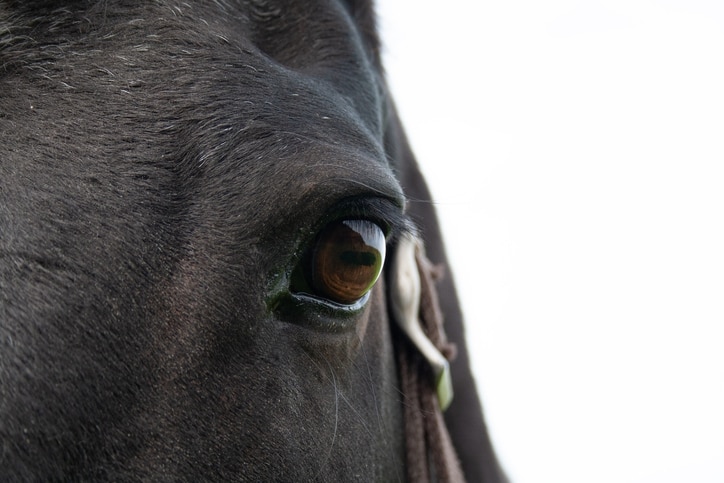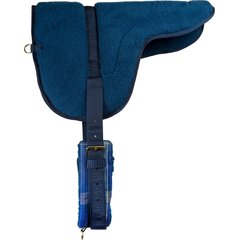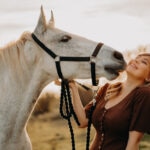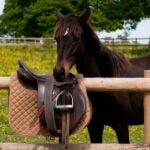What Is a Horse Whisperer? Your Guide to Natural Horsemanship

Photo by anjajuli/iStock / Getty Images Plus via Getty Images
There are many approaches to horse training, but natural horsemanship has steadily gained popularity over the past decades.
Sometimes referred to as horse whispering, natural horsemanship has been championed by noted trainers such as Ray Hunt and Buck Brannaman.
Today, many trainers and horse owners incorporate elements of natural horsemanship into their training.
What Is Natural Horsemanship?
Natural horsemanship is a method of horse training that emphasizes working with horses based on their natural instincts and methods of communication.
“[It’s] the idea that the communication given from the person to the horse is similar to the way horses communicate with each other,” says Jenny Gvozd, owner of Crazy Horse Natural Horsemanship.
“We follow the idea of starting off with the least amount of pressure or energy, and slowly increase until we get a response, and then release by returning to step one or taking off the pressure completely,” Gvozd explains.
Natural horsemanship involves considering each horse as an individual and then building a relationship, says Dawn Bonin, owner of Babcock Hill Horses Naturally in Coventry, Connecticut.
“My personal goal with every horse and rider is to get the relationship so strong, you can go bareback and bridleless,” Bonin says.
Other training methods can be more aggressive, meaning the trainers increase the pressure quickly and significantly if a horse doesn’t respond to a quieter ask. “Natural horsemanship gives a little bit more choice and opportunity to the horse,” says Gvozd.
While the natural horsemanship method may take longer as a training process, it allows a horse to become eager to learn more and grows their confidence. The horse knows that you will take your time to guide them through training, and they can trust your leadership through new tasks.
Recommended Product
How Does Natural Horsemanship Work?
According to Gvozd, horses by nature communicate through body language. For example, a horse might put their ears back, scrunch up their nose, show their teeth, and walk into another horse’s space to signal that horse to move. If that doesn’t work, the horse might bite or kick.
The horses only go as far as necessary to get the response they’re looking for, and natural horsemanship takes the same approach.
Bonin explains that natural horsemanship trainers use a pressure and release method, and they’re constantly looking for signs that the horse understands and is relaxed during the interaction. Horses are very smart creatures and can pick up on many physical and emotional cues.
Trainers use their body language to move the horse’s feet, much in the same way that the horse in the example above uses body language to move another horse in their herd.
“The horse has to be relaxed and with you, first and foremost,” says Bonin. “Then you can start ‘requesting’ the horse participate with you.”
“Feel” is an essential component of natural horsemanship training. Feel is reading the horse and timing your asks appropriately. If your timing is off, the horse won’t clearly understand what you’re asking, but if you have accurate timing, the horse can learn very quickly.
“Feel is so important and so hard to teach to people,” Bonin says. “Feel for me means not only physical and timing but also feeling the horse’s energy and helping them heal on an energetic level.”
What Does a Natural Horsemanship Trainer Do?
Natural horsemanship trainers usually begin training sessions with groundwork, during which they train the horse on foot, Gvozd explains.
Groundwork Comes First
The groundwork gives the trainer a chance to see how the horse is doing on that day, and they will often review some things done in the previous session. If the horse is ready, the trainer may add to the lessons they taught on the ground.
“A natural horsemanship trainer is constantly observing the horse’s body language and taking into account whether the horse is confident with the work being done, and if not, how well are they handling it,” says Gvozd.
That observation can help a trainer determine when a horse is ready to advance in their training, and it also helps them avoid overwhelming the horse.
“Because every horse is different the training progress time will vary, since it is done at the individual horse’s pace,” she says.
Tailor Each Training Session
Bonin explains that there is no set way to work with a horse, so every session may be different. She likes to begin by assessing the horse with groundwork and then progressing to working under saddle.
Bonin also works with the horse’s rider and/or owner to help them better understand what the horse needs, and how to communicate more clearly with the horse.
Find the Root Cause
If Bonin is working with a horse who has demonstrated undesirable behaviors, like kicking or bolting, she always starts by looking for any pain that could be causing the behavior. She estimates that 80% of behavioral issues are pain-related. Remember, if you suspect pain in your horse, consult with a veterinarian, especially if your horse is acting out.
The remaining 20% of behavior problems generally result when a horse doesn’t understand what’s being asked of them.
“Personally, I take [the horse] back to square one and start with basics and groundwork and under saddle [work] and fill in the holes in their training,” she says. “The holes are almost always in the basics and care, caused by people trying to rush their progress.”
Can Anyone Be a Natural Horsemanship Trainer?
“It takes a lot of consistency and patience to become a natural horsemanship trainer, or any horse trainer, for that matter,” says Gvozd. “Anyone can learn these skills, even those [who] may have been using different horsemanship styles.”
Here are some tips for becoming a natural horsemanship trainer:
- Seek an established trainer: Bonin notes that many trainers will take on working students and apprentices, and she recommends that you find a trainer you connect with and ask about any opportunities they offer. “Take what works for you and build your own program,” she says. “The cool thing with horses is you can never know everything, and there is always room to learn more and improve.”
- Practice skills in phases: Be aware of where your body is and what you’re doing.
- Do your research: You can learn about the horse’s perspective and natural communication methods through books and documentaries.
This content was medically reviewed by Kaela Schraer, DVM.




